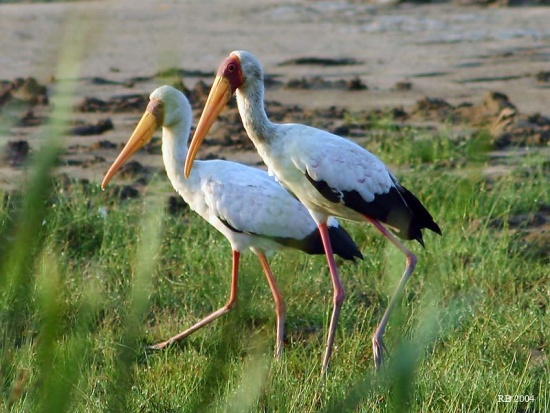| Line 1: | Line 1: | ||
| − | + | ||
;[[:Category:Mycteria|Mycteria]] ibis | ;[[:Category:Mycteria|Mycteria]] ibis | ||
[[Image:Yellow-billed_Stork.jpg|thumb|550px|right|Photo by rudydbn]] | [[Image:Yellow-billed_Stork.jpg|thumb|550px|right|Photo by rudydbn]] | ||
| − | + | ||
==Identification== | ==Identification== | ||
| − | ==Distribution | + | 97cm. Orangey-red face, long and thick, slightly curved and bright yellow bill, long, slender and grey white neck, white back, belly and breast with a small hint of pink on the tips of feathers, black tail and wing quills, long, skinny dark red to a light pink legs. |
| + | |||
| + | ==Distribution== | ||
| + | [[Zambia]], [[Zimbabwe]], and [[Madagascar]]. | ||
| + | |||
| + | ==Taxonomy== | ||
==Habitat== | ==Habitat== | ||
| + | Shallow lakes, mud flats, coastal lagoons and meadows. | ||
==Behaviour== | ==Behaviour== | ||
| + | The diet includes crustaceans, small fish, frogs, insects and worms. | ||
| + | |||
| + | Both sexes build the bulky stick nest; 2-3 eggs are laid on alternate days and are incubated for 30 days. | ||
| + | |||
==External Links== | ==External Links== | ||
{{GSearch|Mycteria+ibis}} | {{GSearch|Mycteria+ibis}} | ||
| − | [[Category:Birds]][[Category:Mycteria]] | + | [[Category:Birds]][[Category:Mycteria]][[category:incomplete]] |
Revision as of 15:14, 23 September 2008
- Mycteria ibis
Identification
97cm. Orangey-red face, long and thick, slightly curved and bright yellow bill, long, slender and grey white neck, white back, belly and breast with a small hint of pink on the tips of feathers, black tail and wing quills, long, skinny dark red to a light pink legs.
Distribution
Zambia, Zimbabwe, and Madagascar.
Taxonomy
Habitat
Shallow lakes, mud flats, coastal lagoons and meadows.
Behaviour
The diet includes crustaceans, small fish, frogs, insects and worms.
Both sexes build the bulky stick nest; 2-3 eggs are laid on alternate days and are incubated for 30 days.




